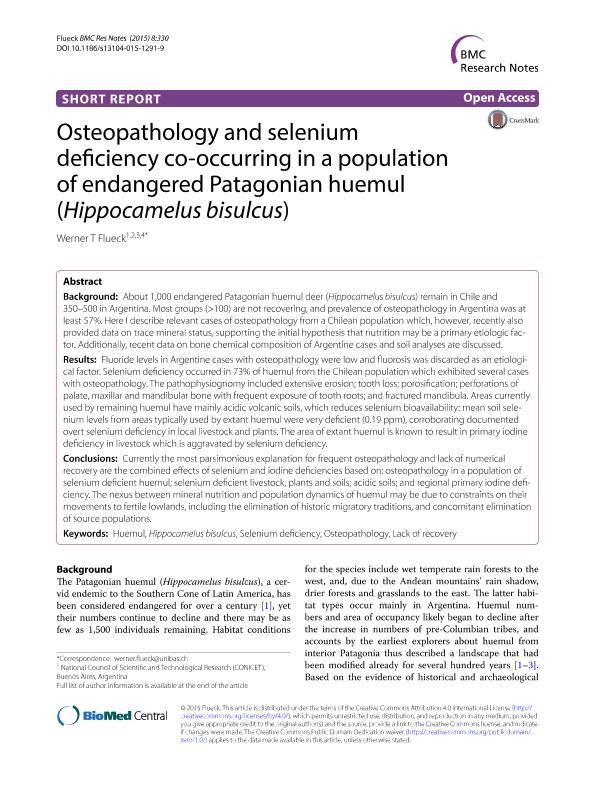Artículo
Osteopathology and selenium deficiency co-occurring in a population of endangered Patagonian huemul (Hippocamelus bisulcus) Veterinary Research
Fecha de publicación:
08/2015
Editorial:
BioMed Central
Revista:
BMC Research Notes
ISSN:
1756-0500
Idioma:
Inglés
Tipo de recurso:
Artículo publicado
Clasificación temática:
Resumen
Background: About 1,000 endangered Patagonian huemul deer (Hippocamelus bisulcus) remain in Chile and 350-500 in Argentina. Most groups (>100) are not recovering, and prevalence of osteopathology in Argentina was at least 57%. Here I describe relevant cases of osteopathology from a Chilean population which, however, recently also provided data on trace mineral status, supporting the initial hypothesis that nutrition may be a primary etiologic factor. Additionally, recent data on bone chemical composition of Argentine cases and soil analyses are discussed. Results: Fluoride levels in Argentine cases with osteopathology were low and fluorosis was discarded as an etiological factor. Selenium deficiency occurred in 73% of huemul from the Chilean population which exhibited several cases with osteopathology. The pathophysiognomy included extensive erosion; tooth loss; porosification; perforations of palate, maxillar and mandibular bone with frequent exposure of tooth roots; and fractured mandibula. Areas currently used by remaining huemul have mainly acidic volcanic soils, which reduces selenium bioavailability: mean soil selenium levels from areas typically used by extant huemul were very deficient (0.19 ppm), corroborating documented overt selenium deficiency in local livestock and plants. The area of extant huemul is known to result in primary iodine deficiency in livestock which is aggravated by selenium deficiency. Conclusions: Currently the most parsimonious explanation for frequent osteopathology and lack of numerical recovery are the combined effects of selenium and iodine deficiencies based on: osteopathology in a population of selenium deficient huemul; selenium deficient livestock, plants and soils; acidic soils; and regional primary iodine deficiency. The nexus between mineral nutrition and population dynamics of huemul may be due to constraints on their movements to fertile lowlands, including the elimination of historic migratory traditions, and concomitant elimination of source populations.
Archivos asociados
Licencia
Identificadores
Colecciones
Articulos(CCT - PATAGONIA NORTE)
Articulos de CTRO.CIENTIFICO TECNOL.CONICET - PATAGONIA NORTE
Articulos de CTRO.CIENTIFICO TECNOL.CONICET - PATAGONIA NORTE
Citación
Fluck, Werner Thomas; Osteopathology and selenium deficiency co-occurring in a population of endangered Patagonian huemul (Hippocamelus bisulcus) Veterinary Research; BioMed Central; BMC Research Notes; 8; 1; 8-2015; 1-9
Compartir
Altmétricas




